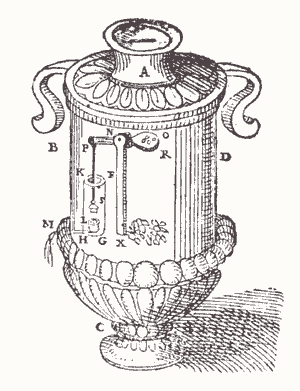The air is thick with the scent of burning incense. A line of worshippers stands in front of a curious bronze contraption. A man steps forward, drops a coin into the machine, and—like magic—holy water flows into his hands. No priest. No human interaction. Just a machine fulfilling a need, 2,000 years before the modern vending machine.
Sounds like something from a sci-fi novel, right? But this was real. This was the work of Hero of Alexandria, a genius who built the world’s first vending machine in the first century AD.
The Mind Behind the Machine: Who Was Hero of Alexandria?
If Leonardo da Vinci had an ancient Greek predecessor, it was Hero. A mathematician, engineer, and inventor, Hero lived in Alexandria, Egypt, during the height of the Roman Empire. His mind churned out ideas that seemed centuries ahead of their time—steam engines, automatic doors, and even theatrical special effects.
But his most famous invention? The vending machine.

How Did It Work? The Ingenious Simplicity of Ancient Automation
The concept was remarkably clever: Worshippers at temples would deposit a coin into a slot, which would fall onto a lever. The weight of the coin would pull the lever down, opening a valve that let water flow out. As the coin slid off, the valve closed, stopping the water flow.
In a world without electricity, computers, or modern mechanics, Hero’s vending machine was an early marvel of automation—and a glimpse into the future.
Why Was It Needed? The Psychology Behind Hero’s Innovation
Hero’s vending machine wasn’t just a cool gadget; it solved a real problem. Ancient temples were often crowded, and priests couldn’t always keep up with the demand for holy water. The machine provided a self-service solution that eliminated human error and potential corruption. It also added an air of mysticism—imagine the awe of worshippers watching a machine “divinely” dispense water at the drop of a coin.
Sound familiar? Today’s vending machines do the same thing: They provide convenience, reduce labor, and make transactions frictionless.
The Domino Effect: What Came Next?
Hero’s work didn’t just fade into obscurity. His writings inspired countless engineers across centuries. His principles of automation, pneumatics, and steam power laid the groundwork for modern machinery.
Fast forward to the 19th century: The first commercial vending machines appeared in England, selling postcards. By the 20th century, vending machines had exploded in popularity, offering snacks, drinks, and even live bait. And today? We have high-tech vending machines selling everything from luxury cars to fresh pizza.
A 2,000-Year-Old Legacy in Every Swipe
Every time you swipe your card at a vending machine, you’re using a principle pioneered by Hero of Alexandria. His invention may not have dispensed soda or candy, but it proved something profound: Machines can serve humans efficiently, predictably, and automatically.
And that was the first step toward the world of automation we live in today.
The Takeaway: Why This Matters More Than Ever
Hero’s vending machine wasn’t just an early engineering marvel—it was a vision of a future where technology enhances human convenience. Today, AI, automation, and self-service technologies continue to evolve at breakneck speed. But the fundamental principle remains the same: Innovation happens when we solve everyday problems in unexpected ways.
So the next time you grab a drink from a vending machine, take a moment to appreciate the genius of a man who lived 2,000 years ago. Because without Hero of Alexandria, who knows how long we would’ve waited for that first can of soda?

